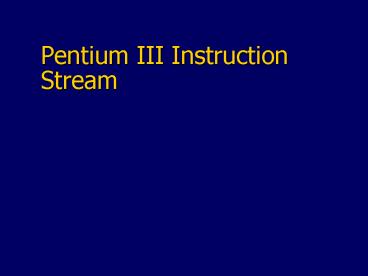Pentium III Instruction Stream - PowerPoint PPT Presentation
Title:
Pentium III Instruction Stream
Description:
Pentium III Instruction Stream ... – PowerPoint PPT presentation
Number of Views:69
Avg rating:3.0/5.0
Title: Pentium III Instruction Stream
1
Pentium III Instruction Stream
2
Introduction
- Pentium III uses several key features to exploit
ILP - This part of our presentation will cover the
methods that the third generation P6/IA32
architecture uses and their advantages/disadvantag
es.
3
Features
- Completely speculative execution
- superscalar issue
- Speculative register renaming
- Deeply pipelined execution
- Large branch prediction unit
4
Pentium III Execution
- Deeply Pipelined
- Over 30 stages for many ops (without miss
penalties) - Several tradeoffs for deeply pipelined models
- Stall penalties
- Clock rate
5
Pentium III Execution Model
- Consists of
- In-order front end/issue
- Out of order execution core
- In order retirement unit (non-speculative)
6
Front End Execution
- ICache access
- Branch prediction
- Decode
- Issue
7
ICache
- Icache is
- 16KB , 4 way set associative, 32 byte cache lines
- L2 (unified)
8
Branch Prediction
- BTB (branch target buffer) decides address of
next executed instruction - Speculative state advantages
- Less complicated recovery
- Less Mispredict costs
- BTB runs off of prefetch
9
Branch Prediction (Cont.)
- Dynamic predictor
- Yehs algorithm
- last 4 directions available per branch address
- One cycle disadvantage on taken branches
- RSB
10
Branch Prediction (Cont.)
- Static predictor
- 6 cycle penalty
- Forward branches(not taken)
- Backward branches(taken)
11
Decode
- Three decode units
- Two simple, one complex
- Micro ops
- RISC type operations
- Can be 1-4 per CISC operation
12
Decode (Cont.)
- Issue problems arise
- Program instruction ordering very important
- Tradeoff
- Issue of 4-wide instructions improves compiler
performance by allowing more optimization
13
Decode (Cont.)
- Williamette (last IA32 architecture) has
- Execution trace cache
- Immediately accessible (no cache hit delay)
- Exploits temporal locality
14
Execution
- Micro-ops follow distinct trails
- RAT (register alias table)
- ROB (re-order buffer)
- Reservation station
- Execution units
15
RAT
- Register Mappings (source, destination)
- Eliminates false dependencies
- In-Order Retirement
- Allows out of order execution from ROB
- Issues up to 3 micro-ops to ROB per cycle
- See any throughput problems?
16
RAT (cont.)
- Can access either ROB or RRF
- Solves true dependencies
- State bits required
- Branch Mispredicts?
- Flush all state(mappings) older than branch
- No new mappings until all current instructions
retired
17
ROB
- ROB is temporary location of queued micro-ops
- 40 entries
- Contain micro-ops, state, and results
18
ROB states
- SD
- Scheduled for execution
- DP
- Micro-op is at head of dispatch queue
- EX
- Currently being executed
- WB
- Completed execution waiting for results
- RR, RT
- Ready for retirement, being retired
19
Reservation Station
20
Reservation Station (Cont.)
- 5 ports for different ops
- FP, Int, MMX, SSE, LSQ ops
- More throughput problems?
- 20 entry queue
- Organization not specified
21
Execution
- Scheduling
- One scheduler for each port
- 20 entry queue optimized by priority algorithm
- Dispatch
- All 5 ports can be dispatched every clock cycle
22
Execution (Cont.)
- Dispatch
- Dcache misses, hazards resolved
- Results written back to ROB
- Resolves dependency chain
23
Retirement
- Results written to RRF
- Non-speculative state
- Register maps deleted, if possible
24
Throughput
25
Area Considerations
- As it turns out
- IA32 architecture doesnt scale entirely well
- Die area a large problem
- Bus / logical complexity grows in non linear
fashion
26
Finally
- It seems that
- IA32 is at an end
- VLIW is next































